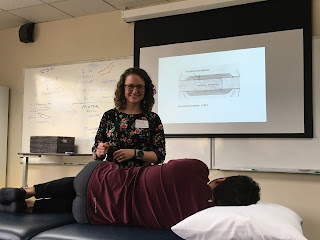 |
| Steve Allen assesses the Lumbar Spine |
This past weekend, I completed my fourth NAIOMT (North American Institute of Orthopedic Manual Therapy) course. I've previously written about my experience with these courses on the blog here following the last one I took way back in 2017. Since I started working at Seattle Children's Hospital in 2017 I've used considerably less manual therapy so these classes have fallen lower on my learning priority list. The kids don't tend to need it so much and I've learned so much about the impact manual therapy sometimes has on patients psychologically that even when I'm in the adult clinic, I'd prefer to use it less. As I continue to grow in my career, I keep learning what I like and what I don't which changes how I interact with patients. In general, I try to avoid "doing things to patients" and prefer to help them learn how to do things for themselves. That's not to say I don't use manual therapy at all... it just isn't my first step most of the time. I do occasionally work with adults and they typically have expectations of receiving this sort of treatment, particularly because of the way the clinics I work at organize their schedules. Sometimes they really do need it - but for sure not always. And in the State of Washington, physical therapists who manipulate the spine need a special certification with specific continuing education, so to maintain my certificate, I took this class.
 |
| Amanda Scharen teaching lumbar instability tests |
To be fair, these NAIOMT courses aren't just about manual therapy, either. Sure, the photos I've included are of a manual technique performed by Steve Allen, NAIOMT faculty member and a Physical Therapy Historian who exudes love for the profession along with my friend and Director of Therapeutic Associates - Queen Anne - Amanda Scharen. I'll even quote Steve from this weekend, "Manual therapy is a small ut vital part of our practice. Combine it with exercise for the best outcomes." But these classes also include advanced review of anatomy and biomechanics, which is important when you haven't studied it specifically since PT School. There are many cases presented during the weekend which challenge clinical reasoning. The partiipants of NAIOMT courses are all physical therapists so there are really interesting discussions about evidence supporting different topics, sometimes even debates, and some of the scientific literature is included for participants to read ahead of time.
 |
| SI Joint - from Wikipedia |
What I've come to understand more and more is that the healthcare you receive from any provider is biased to the beliefs of that provider. For example - if you came to see me and I determined that you had tight hamstrings, I tend to guide you to strengthen the hamstrings in an effort to relieve some of that tension. Some of my coworkers, however, would teach you how to stretch your hamstrings. There are articles supporting both methods. There are groups of people who support both sides. As a patient, if you don't have any prior knowledge on the topic, you're probably just going to take your therapist's word for it that they know what they're talking about. As another example - I've been experiencing some really annoying abdominal pain for the past several months. My GI doctor sent me for tests like an endoscopy and colonoscopy and is treating me for acid reflux. Yes, the medication made me feel better, but I didn't think that was the underlying problem, so I sought out another opinion. She's treating me for something entirely different. Her beliefs about my symptoms match more with my own beliefs of my symptoms and I'm far more optimistic that I'll have a good outcome with this method. As long as the patient gets better, does the method used to get there even matter? Regardless - the evidence is strong that for low back pain, physical therapy should be your number one choice for care. Not medications. Not injections. Not surgery. Not imaging. PHYSICAL THERAPY. Get PT First.
These are the things I think about during these dark Seattle fall-winters.
I have another continuing education class coming in two weekends. I'd imagine it will still be raining then... so a blog post about it is likely. It's very different from this one, so that will be a fun juxtaposition.
No comments:
Post a Comment